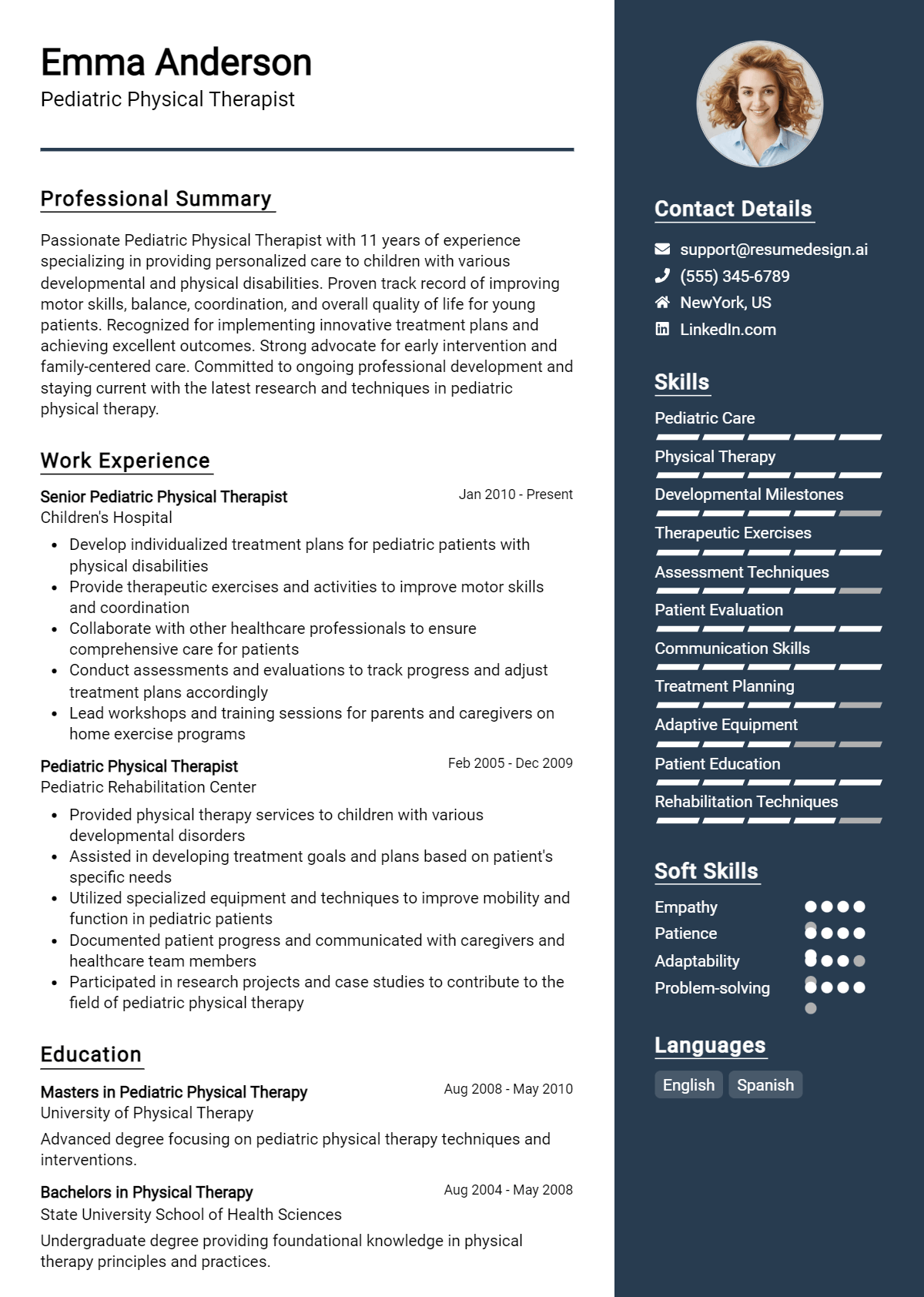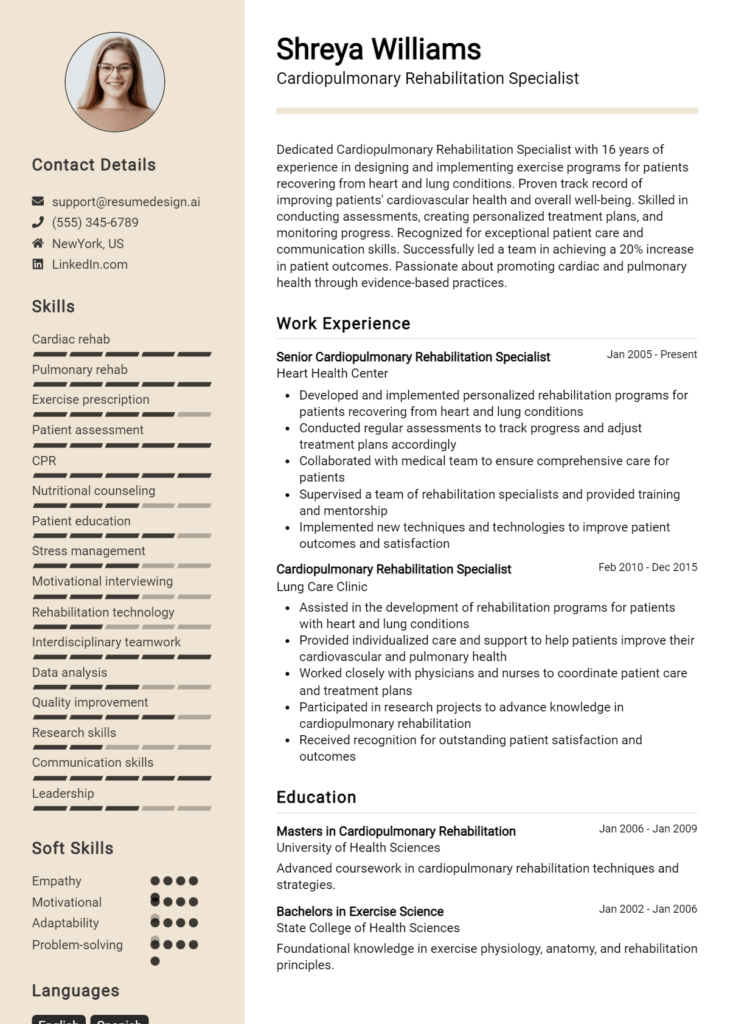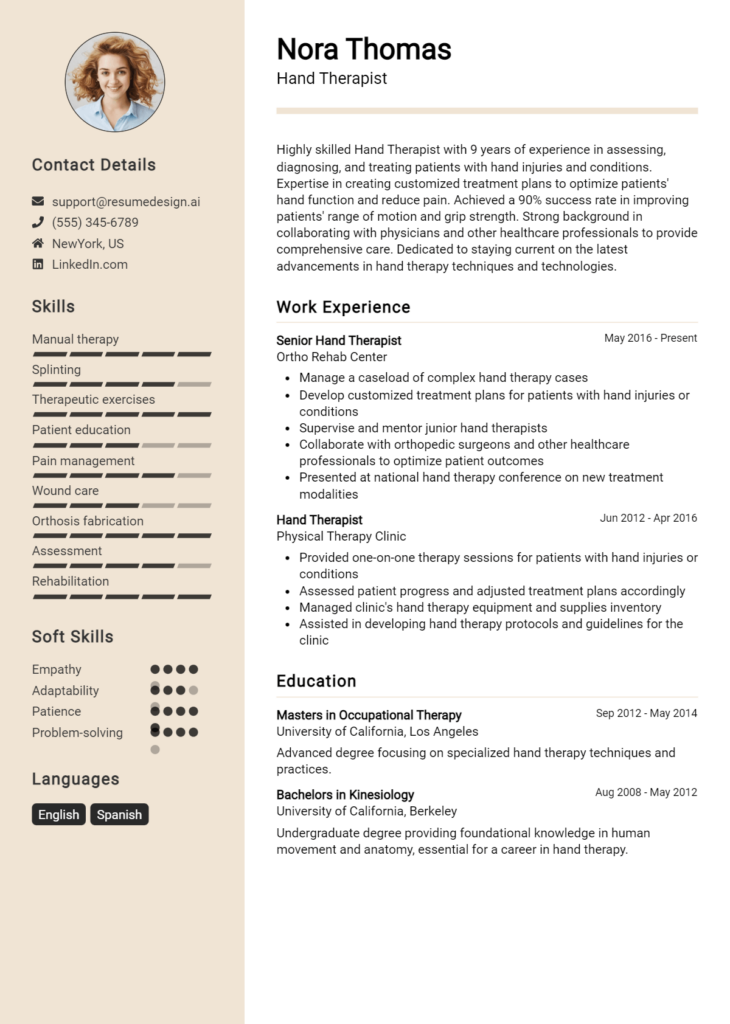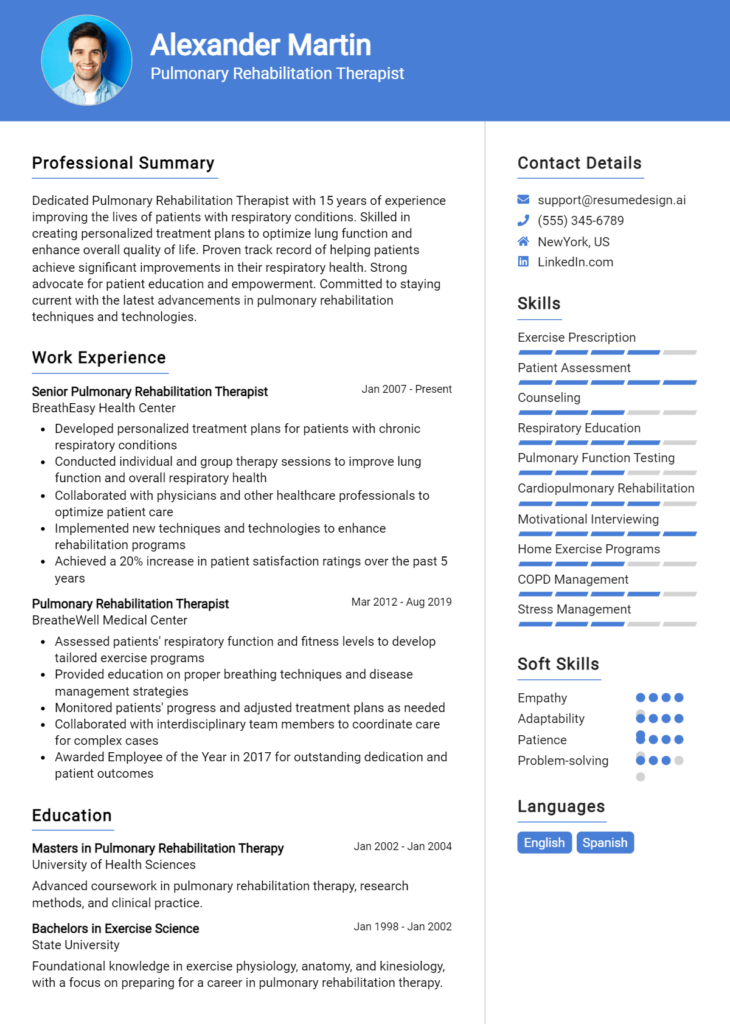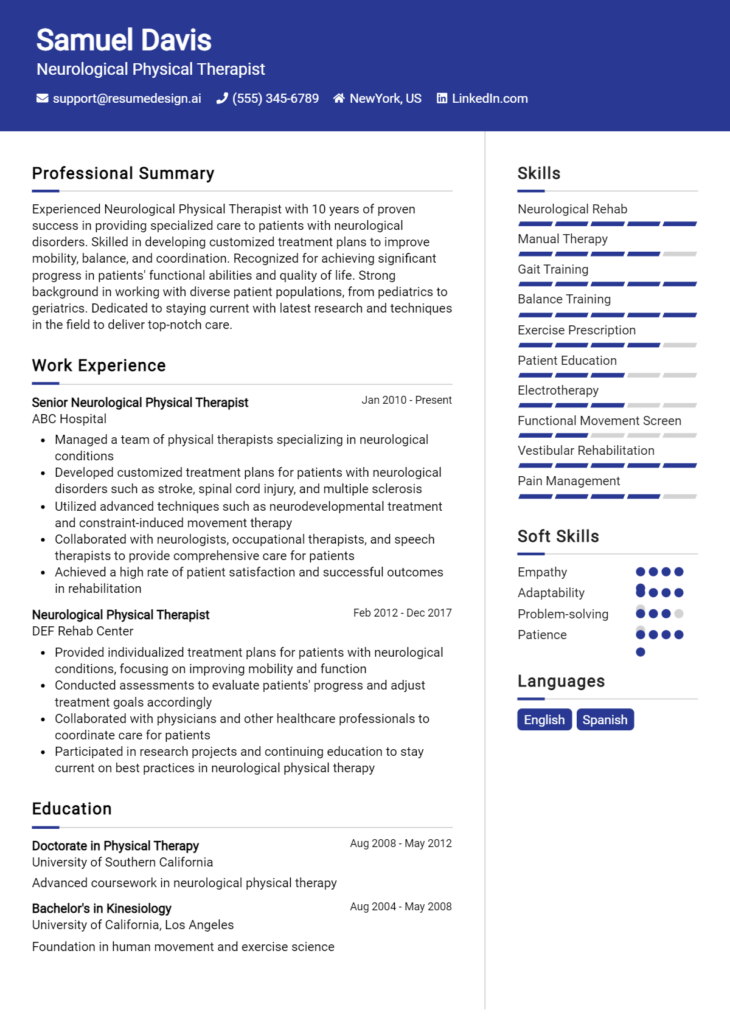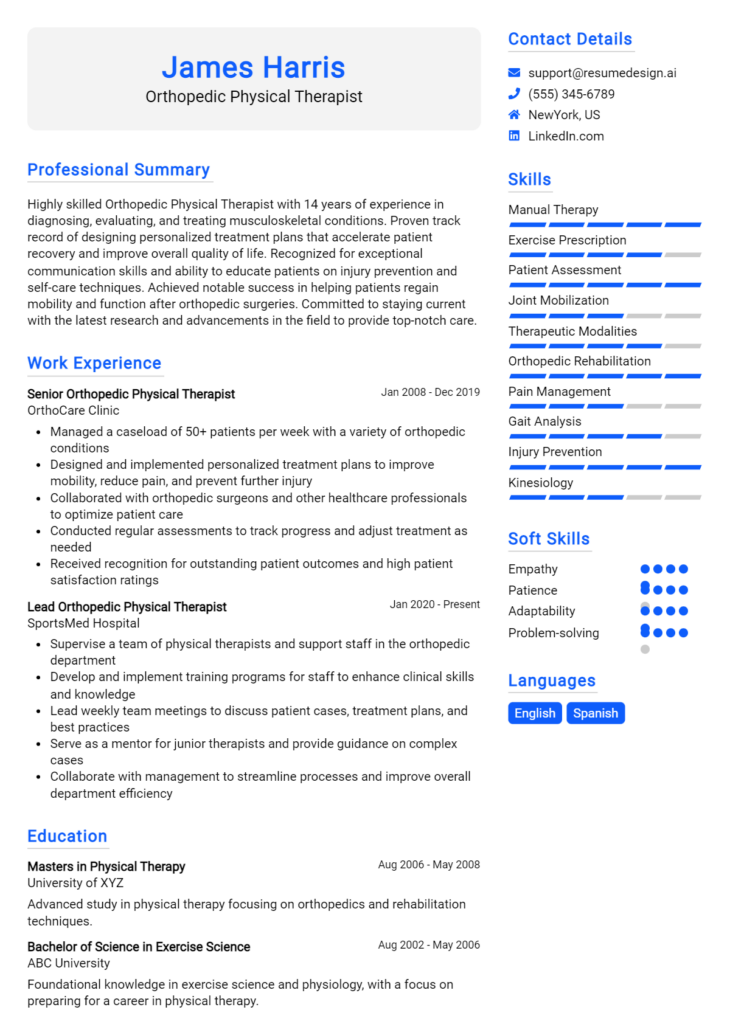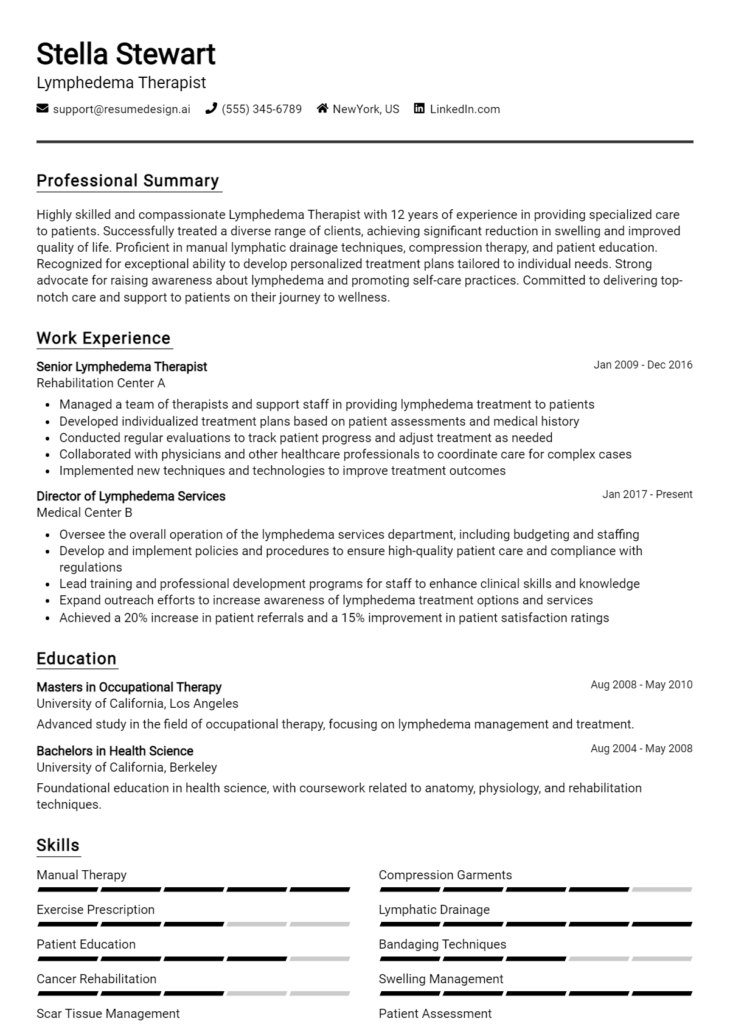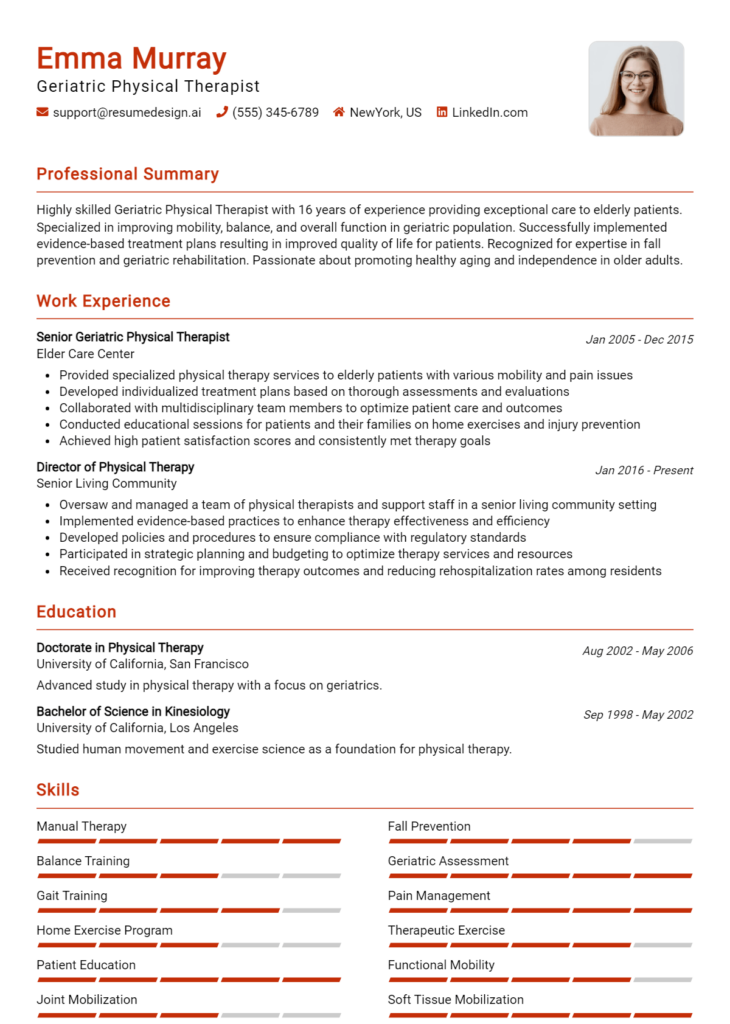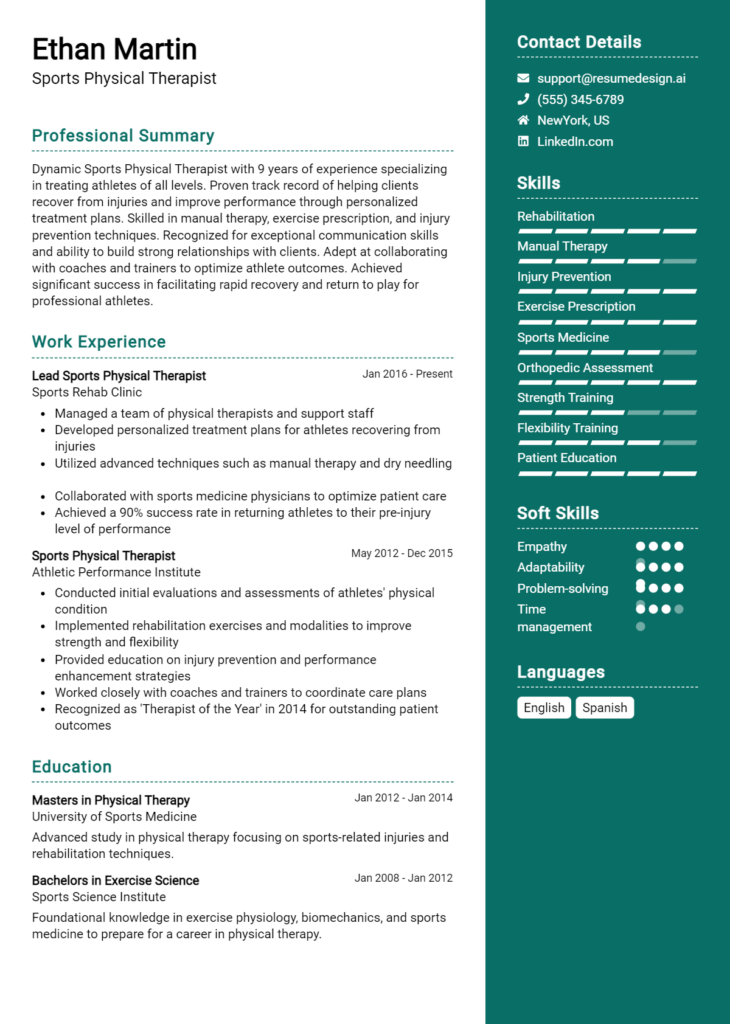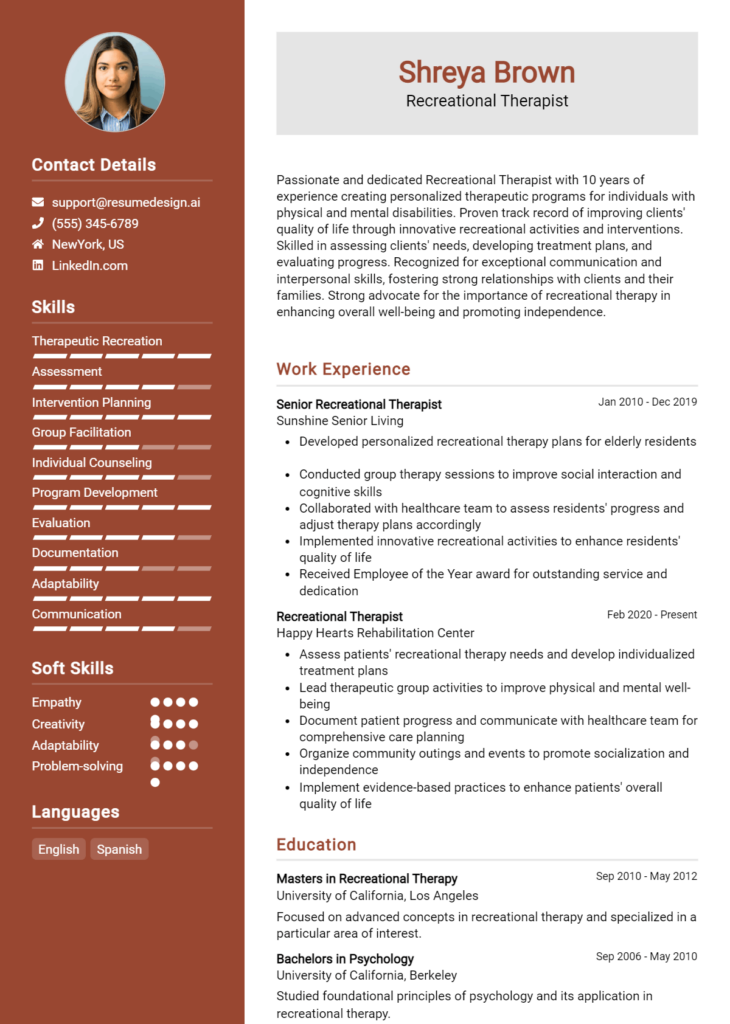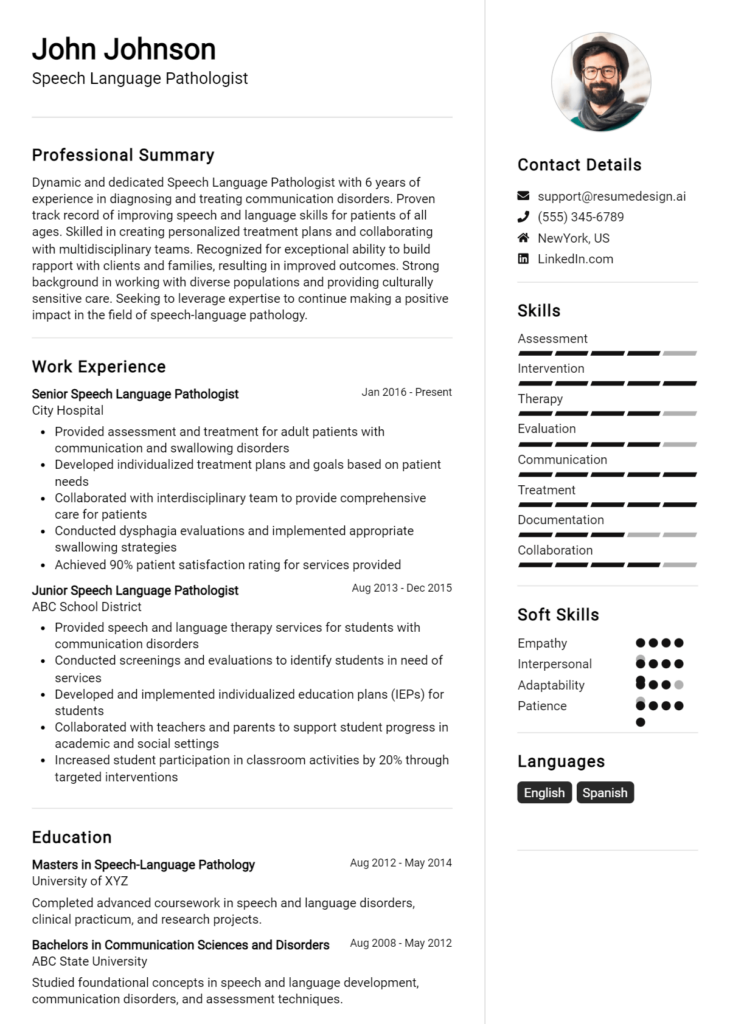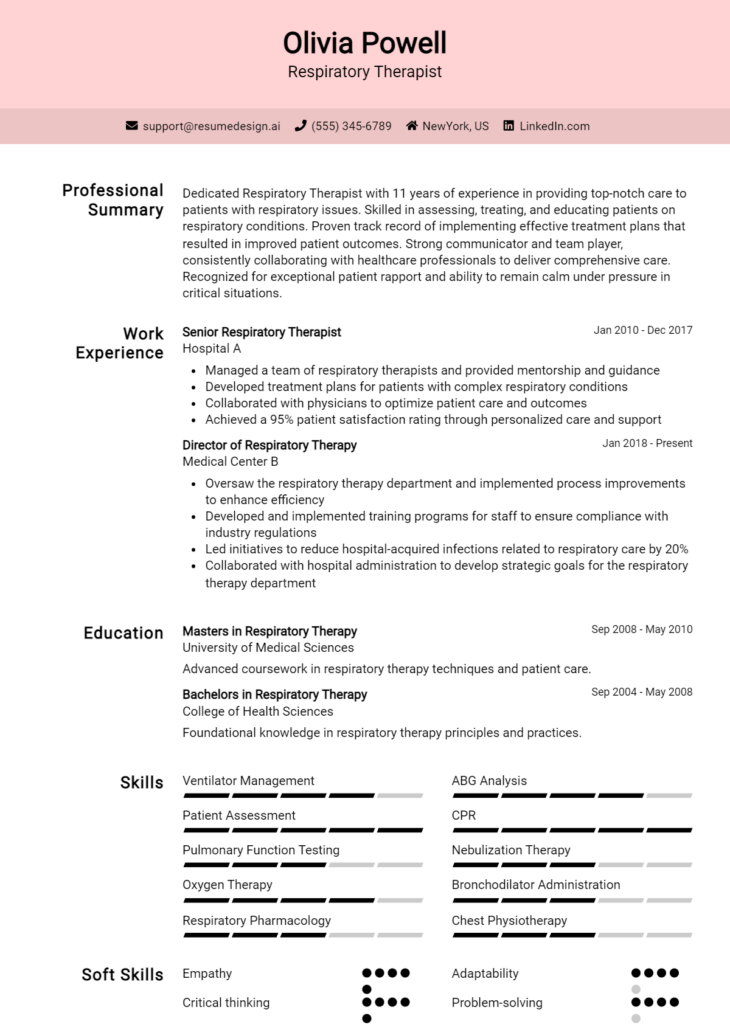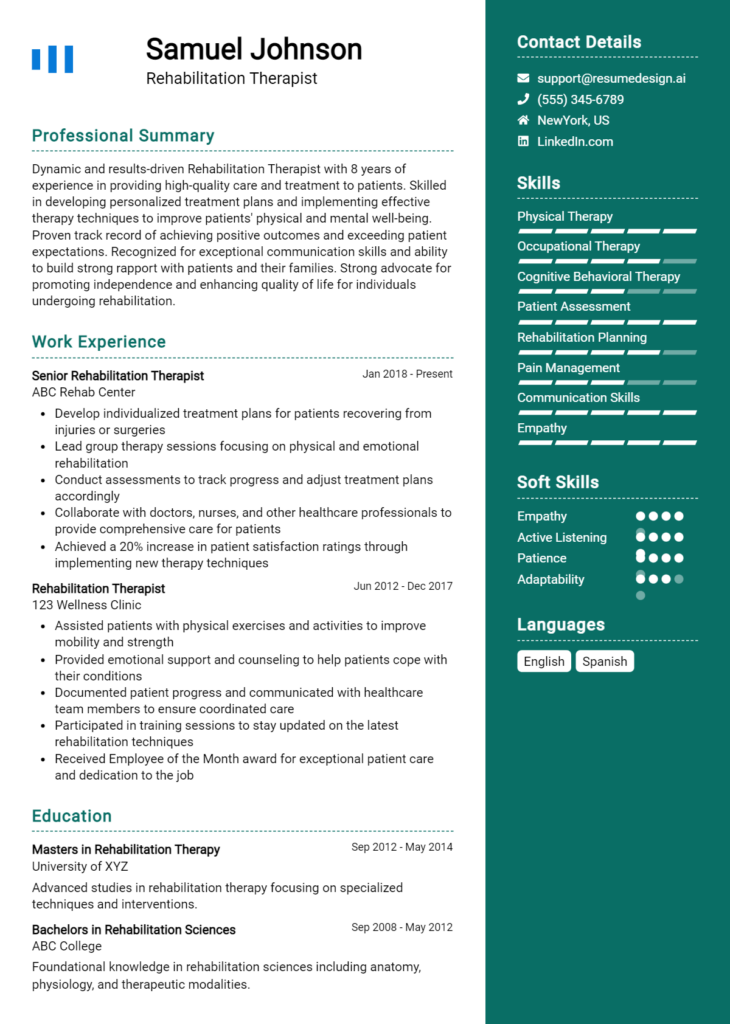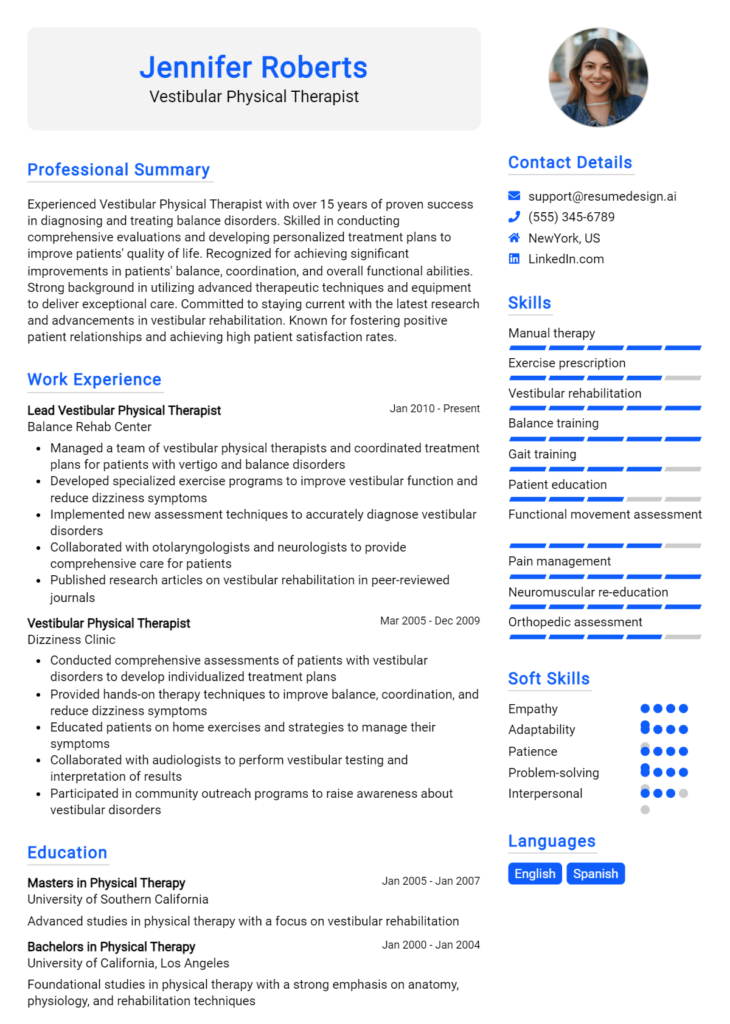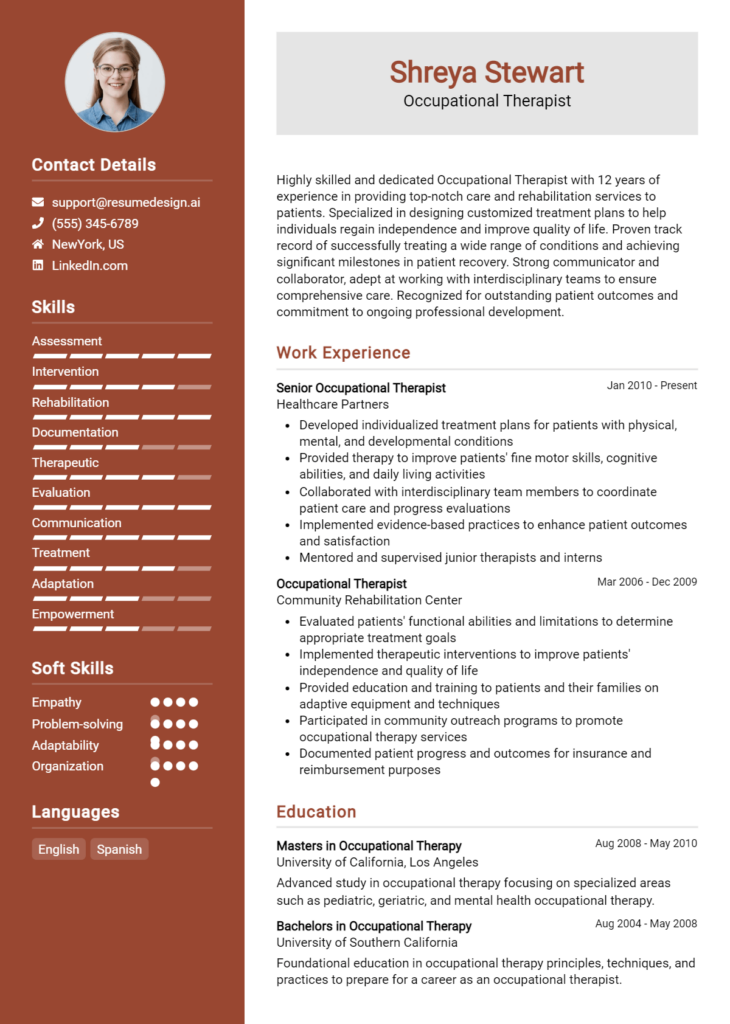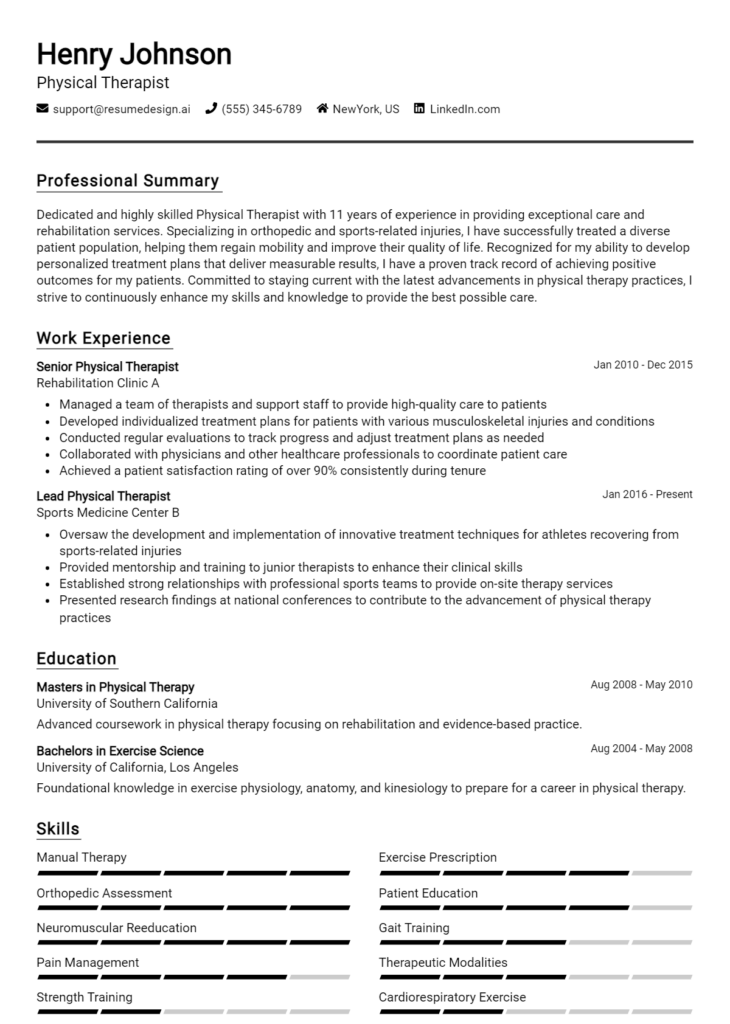Pediatric Physical Therapist Core Responsibilities
A Pediatric Physical Therapist is pivotal in enhancing children's physical development and mobility through tailored therapeutic interventions. Key responsibilities include assessing patient needs, developing individualized treatment plans, and collaborating with multidisciplinary teams, such as occupational therapists and speech therapists. Essential skills encompass technical proficiency in therapeutic techniques, operational efficiency in managing caseloads, and strong problem-solving abilities to adapt interventions. A well-crafted resume highlighting these competencies is crucial for demonstrating an alignment with organizational goals.
Common Responsibilities Listed on Pediatric Physical Therapist Resume
- Conducting comprehensive assessments of children's physical abilities and needs.
- Developing and implementing personalized treatment plans.
- Monitoring patient progress and adjusting therapies accordingly.
- Collaborating with healthcare professionals and families for holistic care.
- Educating parents and caregivers on therapeutic exercises and activities.
- Maintaining accurate and up-to-date patient records and documentation.
- Utilizing specialized equipment and technology for rehabilitation.
- Participating in interdisciplinary team meetings to discuss patient outcomes.
- Conducting community outreach and educational programs.
- Staying current with pediatric physical therapy practices and research.
- Advocating for children’s needs within healthcare and educational settings.
- Providing support and guidance to patients and their families throughout treatment.
High-Level Resume Tips for Pediatric Physical Therapist Professionals
A well-crafted resume is essential for Pediatric Physical Therapist professionals, as it serves as the first impression a candidate makes on potential employers. In a competitive job market, your resume must not only reflect your skills and achievements but also convey your passion for working with children and your expertise in physical therapy. A strong resume can set you apart from other candidates, showcasing your ability to positively impact the lives of young patients. This guide will provide practical and actionable resume tips specifically tailored for Pediatric Physical Therapist professionals, helping you to present your qualifications in the best possible light.
Top Resume Tips for Pediatric Physical Therapist Professionals
- Tailor your resume to the specific job description by incorporating relevant keywords and phrases that match the position.
- Highlight your relevant experience, focusing on roles where you worked directly with children and families.
- Quantify your achievements by using metrics, such as the number of patients treated or improvements in patient outcomes.
- Showcase industry-specific skills, including knowledge of pediatric assessment tools and treatment techniques.
- Include certifications and licenses prominently, emphasizing any specialized training related to pediatric care.
- Use a clean and professional format to enhance readability, ensuring your resume is easy to scan quickly.
- Incorporate a strong summary statement that encapsulates your professional identity and career goals.
- Demonstrate your soft skills, such as communication and empathy, which are crucial in working with children and their families.
- List relevant continuing education courses or workshops that showcase your commitment to professional development.
- Proofread your resume multiple times to eliminate any errors, as attention to detail is critical in healthcare professions.
By implementing these tips, you can significantly increase your chances of landing a job in the Pediatric Physical Therapist field. A well-structured and tailored resume will not only showcase your qualifications but also demonstrate your dedication to providing exceptional care for young patients, making you a compelling candidate in this rewarding profession.
Why Resume Headlines & Titles are Important for Pediatric Physical Therapist
In the competitive field of pediatric physical therapy, a well-crafted resume headline or title holds significant importance. It serves as the first impression a hiring manager will have of a candidate, making it crucial to grab their attention immediately. A strong headline can succinctly summarize a candidate's key qualifications, highlighting their expertise in treating children with diverse physical needs. By ensuring that the headline is concise, relevant, and specifically tailored to the job being applied for, candidates can effectively position themselves as ideal candidates right from the outset.
Best Practices for Crafting Resume Headlines for Pediatric Physical Therapist
- Keep it concise: Aim for one impactful sentence or phrase.
- Be specific: Use keywords related to pediatric physical therapy to showcase your expertise.
- Highlight key qualifications: Focus on skills, certifications, or achievements that set you apart.
- Use action-oriented language: Start with strong verbs to convey proactivity and expertise.
- Tailor to the job description: Reflect the specific role you are applying for in your headline.
- Avoid jargon: Use clear language that is easily understood by hiring managers.
- Make it unique: Stand out from the competition with a distinctive and memorable headline.
- Consider including a quantifiable element: Mention years of experience or number of successful cases if applicable.
Example Resume Headlines for Pediatric Physical Therapist
Strong Resume Headlines
Compassionate Pediatric Physical Therapist with 5+ Years of Experience in Child Rehabilitation
Dedicated Pediatric PT Specializing in Neuromuscular Disorders and Early Intervention Strategies
Results-Driven Pediatric Physical Therapist Committed to Enhancing Children's Mobility and Quality of Life
Licensed Pediatric Therapist with a Proven Track Record of Successful Treatment Plans for Children
Weak Resume Headlines
Therapist Looking for a Job
Pediatric Physical Therapist
Experienced Professional
Strong headlines are effective because they immediately convey the candidate's expertise, specific focus, and relevant experience, making them memorable and engaging for hiring managers. In contrast, weak headlines fail to impress due to their vagueness and lack of specific information, which may leave hiring managers unsure of the candidate's qualifications or unique strengths. A compelling headline not only captures attention but also sets the tone for the rest of the resume, establishing a clear narrative of the candidate's professional identity.
Writing an Exceptional Pediatric Physical Therapist Resume Summary
A well-crafted resume summary is crucial for a Pediatric Physical Therapist as it serves as the first impression for hiring managers. This brief introductory paragraph quickly highlights key skills, relevant experiences, and professional accomplishments, thereby capturing the attention of employers who may be sifting through numerous applications. A strong summary should be concise, impactful, and tailored specifically to the job being sought, ensuring that it reflects the unique qualifications of the candidate and aligns with the needs of the employer.
Best Practices for Writing a Pediatric Physical Therapist Resume Summary
- Quantify achievements: Use numbers to demonstrate the impact of your work, such as the number of patients treated or improvements seen.
- Focus on relevant skills: Highlight specific skills that align with the job description, such as expertise in developmental assessments or therapeutic techniques.
- Tailor for the job description: Customize your summary to reflect the requirements and preferences outlined in the job posting.
- Keep it concise: Aim for 2-4 sentences that deliver maximum impact without overwhelming the reader.
- Use action verbs: Start sentences with strong action verbs to convey confidence and initiative.
- Highlight certifications and specializations: Mention relevant certifications (e.g., pediatric specialization) to enhance credibility.
- Showcase collaboration skills: Emphasize experience working with interdisciplinary teams, which is vital in pediatric settings.
- Convey passion for pediatric care: Include a statement that reflects a commitment to improving the lives of children through physical therapy.
Example Pediatric Physical Therapist Resume Summaries
Strong Resume Summaries
Compassionate Pediatric Physical Therapist with over 5 years of experience specializing in developmental delay interventions. Successfully improved mobility in 90% of patients through tailored therapeutic programs, resulting in enhanced motor skills and confidence.
Dedicated Pediatric Physical Therapist with a proven track record of treating over 200 children with various physical challenges. Achieved a 95% satisfaction rate among parents through effective communication and customized therapy plans that fostered significant progress.
Results-oriented Pediatric Physical Therapist skilled in conducting thorough assessments and developing individualized treatment plans. Demonstrated ability to enhance patient outcomes, achieving a 40% improvement in gross motor skills for children within six months of therapy.
Weak Resume Summaries
Experienced physical therapist looking to work with kids and help them. I have good communication skills and know how to help patients.
Pediatric Physical Therapist with some experience. Interested in providing therapy to children and working with families. I am dedicated to my job.
The strong resume summaries are effective because they provide specific metrics and relevant experiences that demonstrate expertise and successful outcomes in pediatric physical therapy. They are tailored, impactful, and highlight the candidate's capabilities in a way that aligns with what hiring managers typically seek. In contrast, the weak summaries lack detail, quantifiable achievements, and specificity, making them generic and less compelling to potential employers.
Work Experience Section for Pediatric Physical Therapist Resume
The work experience section of a Pediatric Physical Therapist resume is crucial as it serves as a reflection of the candidate's practical abilities, showcasing their technical skills and proficiency in delivering high-quality care to children. This section not only highlights the candidate's direct experience but also demonstrates their capacity to manage teams and collaborate effectively with other healthcare professionals. By quantifying achievements and aligning experiences with industry standards, candidates can effectively illustrate their impact on patient outcomes and their commitment to best practices in pediatric physical therapy.
Best Practices for Pediatric Physical Therapist Work Experience
- Highlight specific therapeutic techniques and modalities used in assessments and interventions.
- Quantify achievements, such as percentage improvements in patient mobility or strength.
- Include collaborative projects with other healthcare providers to demonstrate teamwork.
- Use action verbs to convey a sense of initiative and leadership in care delivery.
- Detail any specialized training or certifications relevant to pediatric care.
- Tailor your experiences to match the job description and industry requirements.
- Showcase involvement in research or evidence-based practice initiatives.
- Provide context for your experiences, such as the age group or conditions treated.
Example Work Experiences for Pediatric Physical Therapist
Strong Experiences
- Implemented a targeted intervention program for children with developmental delays, resulting in a 40% improvement in gross motor skills within six months.
- Collaborated with a multidisciplinary team to establish a comprehensive treatment plan for a group of children with cerebral palsy, increasing patient satisfaction scores by 30%.
- Led a workshop on adaptive equipment use, training 15 staff members and enhancing the quality of care provided to pediatric patients.
- Conducted a research study on the efficacy of play-based therapy, presenting findings at a national physical therapy conference, which contributed to evidence-based practices in pediatric settings.
Weak Experiences
- Worked with children to improve their physical abilities.
- Assisted in therapy sessions as needed.
- Participated in team meetings to discuss patient care.
- Helped with paperwork and documentation for patient records.
The examples listed as strong experiences showcase specific, quantifiable outcomes and demonstrate a clear impact on patient care and teamwork. They provide concrete evidence of the candidate's technical expertise and leadership abilities. In contrast, the weak experiences lack detail and specificity, making it difficult to gauge the candidate's contributions and effectiveness in their role. This highlights the importance of articulating experiences in a way that clearly communicates value and effectiveness in pediatric physical therapy.
Education and Certifications Section for Pediatric Physical Therapist Resume
The education and certifications section of a Pediatric Physical Therapist resume is crucial for demonstrating a candidate's academic accomplishments and professional qualifications. This section not only showcases the necessary degrees and certifications but also reflects the individual's commitment to ongoing learning in a specialized field. Highlighting relevant coursework and specialized training can significantly enhance a candidate's credibility and alignment with the job role, making it essential for standing out in a competitive job market.
Best Practices for Pediatric Physical Therapist Education and Certifications
- Include relevant degrees, such as a Doctor of Physical Therapy (DPT) or a Master's degree in Physical Therapy.
- List industry-recognized certifications, such as the Pediatric Clinical Specialist (PCS) certification.
- Highlight specific coursework that pertains to pediatric care, child development, or therapeutic techniques.
- Emphasize any additional training in specialized areas like neurodevelopmental therapy or sensory integration.
- Ensure all credentials are current and valid, reflecting ongoing professional development.
- Be concise yet detailed, providing enough information to demonstrate expertise without overwhelming the reader.
- Tailor the education section to align with the specific job requirements and preferences outlined in the job description.
- Consider including professional affiliations or memberships in relevant organizations to further enhance credibility.
Example Education and Certifications for Pediatric Physical Therapist
Strong Examples
- Doctor of Physical Therapy (DPT), University of XYZ, Graduated May 2020
- Pediatric Clinical Specialist (PCS) Certification, American Board of Physical Therapy Specialties, Certified 2021
- Coursework in Pediatric Rehabilitation and Child Development, University of XYZ
- Advanced Certification in Neurodevelopmental Treatment (NDT), Completed March 2022
Weak Examples
- Bachelor of Science in Biology, University of ABC, Graduated 2015
- Certification in General Fitness Training, Completed 2016
- Basic First Aid and CPR Certification, Expired 2020
- Online Course in Adult Physical Therapy Techniques, Completed 2019
The strong examples are considered effective because they directly relate to pediatric physical therapy, showcasing relevant degrees and specialized certifications that reflect the candidate's focus and expertise in the field. In contrast, the weak examples are less effective as they include outdated or irrelevant credentials that do not apply to the pediatric specialization, potentially diminishing the candidate's appeal to employers seeking expertise in child-focused therapy.
Top Skills & Keywords for Pediatric Physical Therapist Resume
As a Pediatric Physical Therapist, showcasing the right skills on your resume is crucial for standing out in a competitive job market. The ability to effectively assess and treat children with various physical challenges relies not only on your technical knowledge but also on your interpersonal skills. Employers look for a blend of hard and soft skills that demonstrate both your clinical expertise and your ability to connect with young patients and their families. Highlighting these skills can significantly enhance your resume, making it more attractive to hiring managers in the healthcare industry.
Top Hard & Soft Skills for Pediatric Physical Therapist
Soft Skills
- Empathy
- Communication Skills
- Patience
- Active Listening
- Team Collaboration
- Adaptability
- Problem-Solving
- Motivation
- Creativity
- Time Management
- Compassion
- Cultural Competency
- Conflict Resolution
- Attention to Detail
- Encouragement
Hard Skills
- Pediatric Rehabilitation Techniques
- Gait Analysis
- Manual Therapy
- Neuromuscular Re-education
- Orthopedic Assessment
- Developmental Milestone Evaluation
- Therapeutic Exercise Prescription
- Assistive Device Training
- Knowledge of Pediatric Conditions (e.g., cerebral palsy, autism)
- Patient Documentation and Record Keeping
- Use of Therapeutic Modalities
- Knowledge of Safety Protocols
- CPR and First Aid Certification
- Evaluation and Treatment Planning
- Understanding of Anatomy and Physiology
- Knowledge of Insurance and Billing Practices
For more guidance on how to effectively showcase your skills and work experience, be sure to explore the available resources.
Stand Out with a Winning Pediatric Physical Therapist Cover Letter
Dear [Hiring Manager's Name],
I am writing to express my interest in the Pediatric Physical Therapist position at [Company/Organization Name], as advertised on [where you found the job listing]. With a Master’s degree in Physical Therapy and over [X years] of experience working with children of diverse abilities, I am excited about the opportunity to contribute to your team. My passion for pediatric physical therapy is driven by my commitment to helping young patients achieve optimal mobility and independence, and I believe my skills align perfectly with your organization’s mission to provide compassionate and effective care.
In my previous role at [Previous Employer], I developed and implemented individualized treatment plans for children with various conditions, including developmental delays, cerebral palsy, and orthopedic issues. I utilized evidence-based practices and innovative therapeutic interventions to enhance motor skills, coordination, and overall physical functioning. Collaborating closely with families, caregivers, and multidisciplinary teams, I ensured that my approach was holistic and tailored to each child’s unique needs. This collaboration not only fostered a supportive environment for the child but also empowered parents with the knowledge and techniques necessary to assist in their child’s progress at home.
I am particularly drawn to [Company/Organization Name] because of your commitment to [specific value or initiative of the organization]. I admire your emphasis on family-centered care and your focus on creating a positive and engaging environment for children. I am eager to bring my experience in implementing playful and motivating therapeutic strategies that encourage participation and enjoyment during therapy sessions. My goal as a pediatric physical therapist is not only to enhance physical abilities but also to inspire confidence and joy in my young patients.
Thank you for considering my application. I am looking forward to the opportunity to discuss how my background, skills, and enthusiasms can be aligned with the goals of [Company/Organization Name]. I am excited about the possibility of contributing to your team and making a difference in the lives of children and their families. Please feel free to contact me at [Your Phone Number] or [Your Email Address] to schedule a conversation.
Sincerely,
[Your Name]
Common Mistakes to Avoid in a Pediatric Physical Therapist Resume
When crafting a resume for the role of a Pediatric Physical Therapist, it is crucial to present your skills and experiences effectively, as this can significantly impact your chances of landing an interview. However, many candidates make common mistakes that can detract from their qualifications and experiences. Avoiding these pitfalls can help you create a strong, professional resume that stands out in a competitive job market.
Neglecting to Tailor Your Resume: Failing to customize your resume for each specific job application can make it appear generic. Highlight the skills and experiences that align with the job description.
Overloading with Jargon: Using excessive clinical terminology can confuse hiring managers who may not be familiar with specialized terms. Keep language clear and accessible.
Ignoring Soft Skills: While technical skills are vital, soft skills such as communication, empathy, and teamwork are equally important in pediatric therapy. Be sure to include examples that demonstrate these abilities.
Using an Unprofessional Format: A cluttered or overly complex resume format can detract from your qualifications. Opt for a clean, easy-to-read layout that highlights key information.
Listing Responsibilities Instead of Achievements: Instead of merely stating job duties, focus on specific achievements and outcomes. Use quantifiable metrics, when possible, to showcase your impact.
Failing to Include Relevant Certifications or Licenses: Ensure that you highlight any relevant certifications, licenses, and continuing education that are pertinent to pediatric physical therapy. This information can set you apart from other candidates.
Neglecting to Proofread: Spelling or grammatical errors can create a negative impression. Always proofread your resume and consider asking someone else to review it for clarity and professionalism.
Being Too Lengthy: Keeping your resume concise is important. Aim for one page, especially if you have less than ten years of experience. Highlight the most relevant information to maintain the reader's attention.
Conclusion
As a Pediatric Physical Therapist, your role is vital in improving the quality of life for children with physical challenges. Throughout this article, we've discussed the essential skills and qualifications needed for this position, including a deep understanding of developmental milestones, manual therapy techniques, and the ability to create tailored treatment plans. Additionally, we emphasized the importance of effective communication with families and collaboration with other healthcare professionals to ensure comprehensive care.
In conclusion, it’s crucial to present your qualifications and experiences clearly and effectively on your resume. To stand out in this competitive field, consider reviewing your Pediatric Physical Therapist resume to ensure it highlights your strengths and achievements.
To assist you in this process, a variety of tools are available to help you craft a standout application. Explore resume templates to find a design that suits your style, use the resume builder for easy customization, and check out resume examples for inspiration. Additionally, don’t forget to create a compelling narrative with our cover letter templates.
Take the time to refine your resume today and put your best foot forward in your job search!

